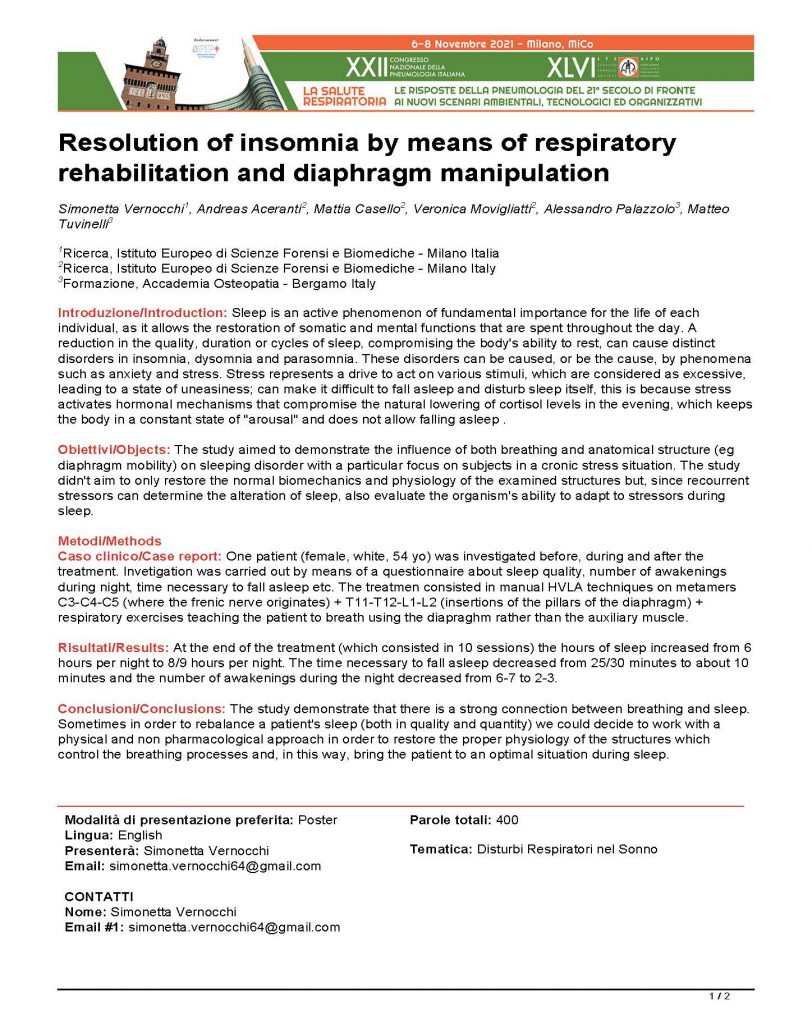Introduzione/Introduction: Sleep is an active phenomenon of fundamental importance for the life of each individual, as it allows the restoration of somatic and mental functions that are spent throughout the day. A reduction in the quality, duration or cycles of sleep, compromising the body’s ability to rest, can cause distinct disorders in insomnia, dysomnia and parasomnia. These disorders can be caused, or be the cause, by phenomena such as anxiety and stress. Stress represents a drive to act on various stimuli, which are considered as excessive, leading to a state of uneasiness; can make it difficult to fall asleep and disturb sleep itself, this is because stress activates hormonal mechanisms that compromise the natural lowering of cortisol levels in the evening, which keeps the body in a constant state of “arousal” and does not allow falling asleep .
Obiettivi/Objects: The study aimed to demonstrate the influence of both breathing and anatomical structure (eg diaphragm mobility) on sleeping disorder with a particular focus on subjects in a cronic stress situation. The study didn’t aim to only restore the normal biomechanics and physiology of the examined structures but, since recourrent stressors can determine the alteration of sleep, also evaluate the organism’s ability to adapt to stressors during sleep.
Caso clinico/Case report: One patient (female, white, 54 yo) was investigated before, during and after the treatment. Invetigation was carried out by means of a questionnaire about sleep quality, number of awakenings during night, time necessary to fall asleep etc. The treatmen consisted in manual HVLA techniques on metamers C3-C4-C5 (where the frenic nerve originates) + T11-T12-L1-L2 (insertions of the pillars of the diaphragm) + respiratory exercises teaching the patient to breath using the diapraghm rather than the auxiliary muscle.
Risultati/Results: At the end of the treatment (which consisted in 10 sessions) the hours of sleep increased from 6 hours per night to 8/9 hours per night. The time necessary to fall asleep decreased from 25/30 minutes to about 10 minutes and the number of awakenings during the night decreased from 6-7 to 2-3.
Conclusioni/Conclusions: The study demonstrate that there is a strong connection between breathing and
sleep. Sometimes in order to rebalance a patient’s sleep (both in quality and quantity) we could decide to work with a physical and non pharmacological approach in order to restore the proper physiology of the structures which control the breathing processes and, in this way, bring the patient to an optimal situation during sleep.
Authors: S. Vernocchi, A. Aceranti, M. Casello, V. Movigliatti, A. Palazzolo, M. Tuvinelli
Published: Journal of Respiratory Medicine, Noc 2021
Presented: Poster at AIPO National Congress of Respiratory Medicine, 2021


